Browse Sheets By Problem Type
×
NumberLines & Value Mats
Link

Filling in NumberLines
2md6


×
Description:
"This worksheet is designed to enhance children's numerical aptitude by filling in number lines. Covering 10 engaging math problems, it aids in developing their understanding of numerical sequences and order. Tailored to fit distinct learning methods, the worksheet can be customized to individuals, transformed into interactive flashcards, or utilized in distance learning platforms, providing versatile options in bolstering crucial math skills."

×
Student Goals:
Enhancement of Number SenseUpon completion of the worksheet, students will have significantly enhanced their number sense, building a stronger foundation for handling various mathematical tasks. They will better understand and appreciate the relationship between numbers, which is essential in their progress towards learning more advanced mathematical concepts.Specific Number Placement SkillsThe worksheet provides an opportunity for students to learn and practice number placement within a number sequence. This skill is crucial as it taps into their logical thinking abilities and influences how they approach problem-solving tasks. The students should be able to competently place missing numbers in their correct positions in a number sequence after completing the worksheet.Number Sequencing MasteryStudents will be able to comprehend and implement the skill of number sequencing effectively. This is a fundamental component of math and further influences their capability to deal with mathematical operations like addition and subtraction. The worksheet challenges their mental representation of numbers, in effect, boosting sequence understanding.Improvement in Counting SkillsWorking on the worksheet enables students to practice and improve their counting skills. Whether they are counting forwards or backwards, their flexibility in counting is tested, developed, and perfected. This ability is not only essential in math but also in their day-to-day activities.Boosted Concentration LevelsSolving the number line problems on the worksheet requires intense concentration and attention to detail. Thus, students will be able to sharpen their focus and attention span. This will prove beneficial in all areas of their academic journey and beyond.Acceleration of Math SpeedSpeed and accuracy are significant components of math competence. As the students fill in the number lines, they simultaneously work on their speed. The repetitive nature of the worksheet should help students accomplish mathematical tasks more quickly over time.Enhancement of Cognitive SkillsCompleting the worksheet exercises the students' brains, therefore, enhances their cognitive skills, especially in terms of problem-solving, reasoning, and logical thinking. The learning process is beneficial to their overall cognitive development.Provision of a Learning ReferenceThe completed worksheet serves as a learning reference. By referring to their worksheet, students will be able to reinforce what they've learned and gain better mastery over number lines and the respective number placements.


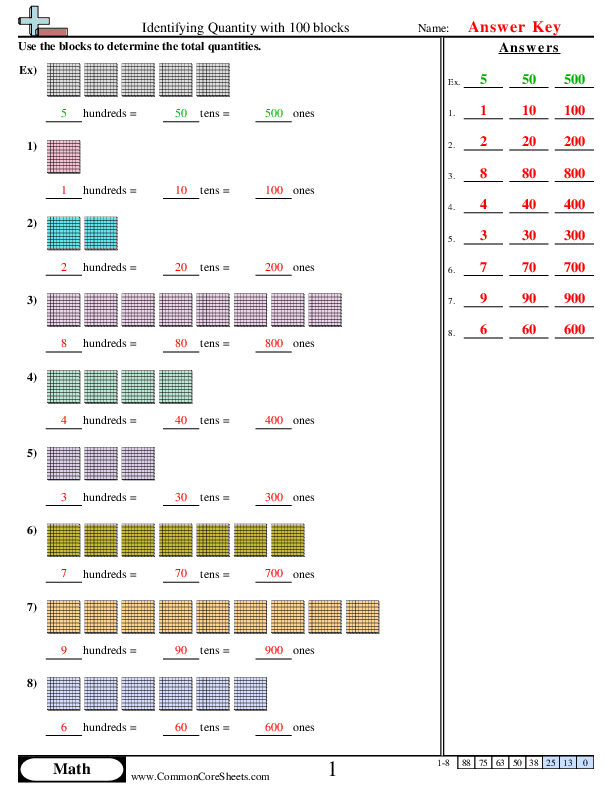
Identifying Quantity with 100 blocks.
2nbt1a


×
Description:
"This worksheet is designed to reinforce children’s understanding of numbers and quantities in hundreds, tens, and ones format. Featuring eight engaging math problems, the worksheet challenges learners to identify the value of hundreds, tens, and ones in numbers like 300, 500, and 700. Adaptable for various learning styles, its format can be customized, used as flash cards, or incorporated into distance learning curriculums, offering a versatile tool to strengthen foundational math skills in an engaging way."

×
Student Goals:
Master Basic Math ConceptsStudents should be able to have a firm grasp of basic math concepts, particularly the value of numbers and the quantity they represent. They should understand the number system, identify and differentiate between hundreds, tens, and ones. This foundational knowledge will aid them in tackling more complex math equations in the future.Enhance Critical Thinking and Problem-solving SkillsUpon completion of the worksheet, students should be able to apply learned concepts to solve problems. By determining the quantity that each block set of hundreds, tens, and ones represents, they enhance their critical thinking and problem-solving skills, which are invaluable in everyday life and across academic disciplines.Grow Counting and Calculation SkillsAfter completing the worksheet, students should show significant improvement in their counting and calculation skills. They get to practice counting by hundreds up to a thousand, reinforcing their ability to count and calculate quickly and accurately.Develop Understanding of Place ValuesThe teaching of hundreds, tens, and ones forms the core of the place value system, which is a fundamental concept in arithmetic and number theory. Students should be able to recognize and understand how place values work and apply this knowledge when reading and composing numbers.Boost Cognitive Ability and FocusThe worksheet targets the enhancement of children's cognitive abilities and their focus. By following the set of problems and solving them, students train their brain to focus, maintain attention, and carry out critical cognitive functions.Build Confidence in MathSuccessfully completing the worksheet should instill confidence in students, allowing them to approach Math's future tasks and challenges with less fear and hesitation. This confidence can enhance their overall academic performance and attitude towards learning.


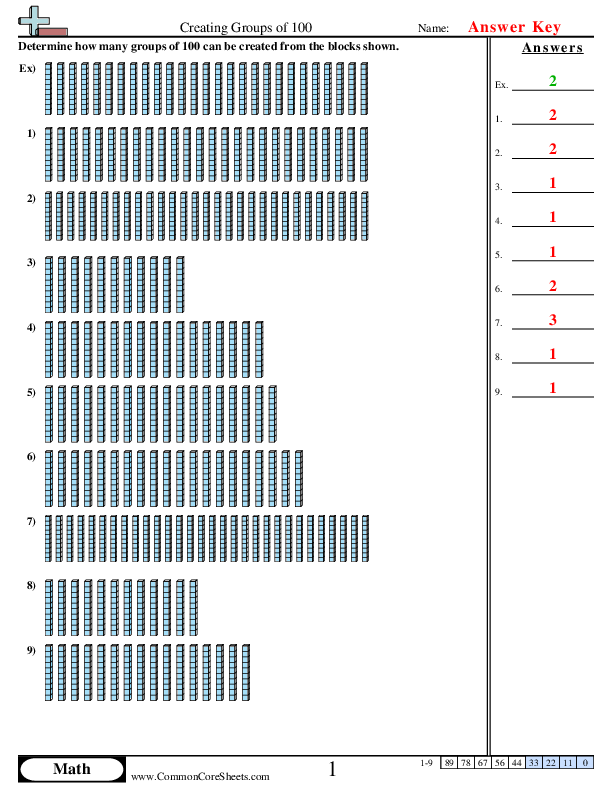
Creating Groups of 100
2nbt1a


×
Description:
"This worksheet is designed for children to enhance their math skills by creating groups of 100. Comprising of 9 unique problems, it simplifies numerical concepts into engaging tasks. Featuring customization, it can be transformed into flash cards, serving as an effective tool for distance learning. With its flexibility and interactivity, this resource promotes fun while learning mathematics."

×
Student Goals:
ComprehensionBy completing this worksheet, students should have developed an understanding of how to create groups of 100. This fundamental mathematical concept enables them to subdivide large numbers into easily manageable groups, greatly improving their numeric comprehension skills. They would also have developed mental math strategies for dealing with numbers, making it easier for them to perform quick calculations in their heads.Critical ThinkingStudents should showcase an enhanced ability to solve problems. They would be able to strategize, deduce, and sift through various possibilities to determine the correct groupings of numbers. This critical thinking capability is not exclusive to math alone. Properly cultivating it can transfer seamlessly into other subjects or areas where problem-solving abilities are needed. This worksheet helps in tackling complex problems by breaking them down into smaller, manageable parts.Number FluencyThe completion of this worksheet should correlate to increased numerical fluency. That is, they would demonstrate a strong familiarity with numbers, and their proficiency in manipulating them should be evident. Participating in exercises, where they need to create groups of 100, would have effectively reinforced the concept of the base-10 number system, thereby ameliorating their numerical agility.Confidence and EncouragementBy completing these tasks, students would have taken steps towards improved confidence in their mathematical abilities. The sense of accomplishment found in successfully creating groups of 100 would serve as a motivational boost, encouraging them to engage further with mathematical problem-solving activities. This can be crucial in setting a robust foundation for more complex mathematical theories and numerical applications in the future.Integration of KnowledgeBeyond gaining familiarity with numbers, students would learn how to integrate different parts of knowledge in a cohesive manner. They would understand number operations, connections among numbers, and how they can break down and group numbers in varied ways for different purposes, thus showing evidence of considerable cognitive growth in number sense. This worksheet stands as a stepping stone in the journey to develop sophisticated numerical capabilities that are the backbone of higher-level mathematic comprehension.


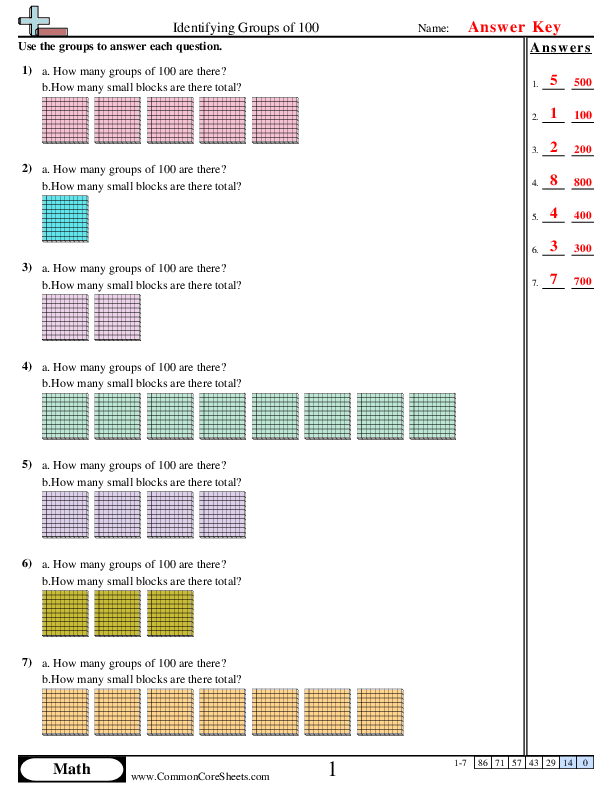
Identifying Groups of 100
2nbt1b


×
Description:
"This worksheet is designed to boost children's mathematical skills by identifying groups of 100. Comprising seven problems, each with two questions, students are asked to define the number of groups that make up 100 and determine the total number of small blocks. Highly versatile, this tool can be tailored to individual learning needs, transformed into engaging flashcards, or incorporated into distance learning platforms to create a flexible, interactive, and stimulating learning environment."

×
Student Goals:
Understanding Quantity GroupingsAfter completing this worksheet, students should be able to understand the concept of quantity groupings, specifically centered around the number 100. They will learn to conceptualize what it means for quantities to be grouped into hundreds, enabling them to more readily grapple with larger numbers.Counting and Calculation SkillsCompleting the worksheet should improve students' ability to count and perform basic mathematical operations. The consistent repetition will enable them to become more adept at quickly identifying groups of 100, improving their mental arithmetic skills.Developing Problem Solving AbilitiesStudents will learn how to approach and solve problems. By working through a variety of tasks, students will gain the ability to take information, process it, and determine a solution based on that information. This facilitates the development of logical thinking and analytical skills.Grasping Mathematical ConceptsUpon completing the worksheet, students will have a better grasp on larger mathematical concepts. This includes understanding the relationships between numbers, the importance of grouping in mathematics, and how these concepts relate to each other within the subject of mathematics. This understanding will prove invaluable as students progress to more complex topics.Increasing Numeracy ConfidenceAs students work through the problems and become more comfortable with the concept of grouping into hundreds, they will increase their confidence in their numeracy abilities. This self-assurance is not only important for their ongoing mathematical education but also contributes to their general academic self-efficacy.Understanding Number RelationshipsBy focusing on identifying groups of 100, students will gain a deeper understanding of the relationships between numbers. They will improve their comprehension of how quantities and numbers can be broken down and grouped, building a robust foundation for future mathematical endeavors.Practicing Application of KnowledgeLastly, accomplishing this worksheet allows students to practice applying their new knowledge. From recognizing groups of 100 to calculating the total number of smaller blocks, students will see how the principles they are learning can be directly applied in mathematical problems, reinforcing the practicality of the skills they are being taught.


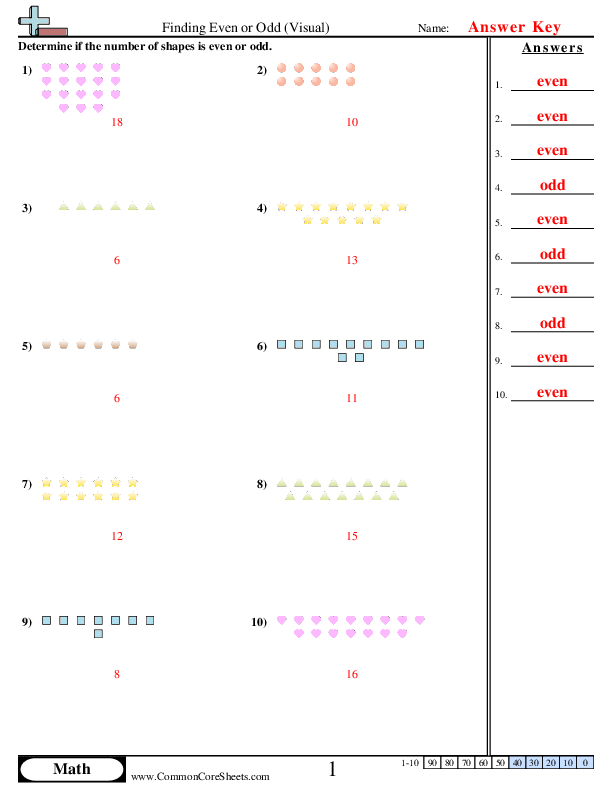
Finding Even or Odd (visual)
2oa3


×
Description:
"This worksheet is designed to strengthen a child's understanding of even and odd numbers. The math-focused sheet provides ten visual problems that encourage critical thought. This resource is flexible, with options to customize content or convert to flashcards, and it can fit seamlessly into a distance learning curriculum. It's a valuable tool for fostering young learners' numerical skills."

×
Student Goals:
Understanding of Odd and Even NumbersUpon completion of this worksheet, students will have a better understanding of odd and even numbers. They will be able to identify and differentiate between these two types of numbers through visual aids. This critical math concept will form a solid foundation for more advanced mathematics concepts they will encounter in higher grades.Development of Analytical SkillsBy solving the problems in the worksheet, students will develop their analytical skills. They will be challenged to think logically and analytically in order to determine whether a number is odd or even. This worksheet will aid in honing their problem-solving abilities, a skill that is not only important in mathematics but in life.Memory and Recall EnhancementThe repeated exposure to math problems will help students in enhancing their memory and recall. Being able to quickly and accurately determine whether a number is odd or even requires recall of learned concepts, a skill that will also transfer to other areas of study and life.Boost in ConfidenceAfter completing this worksheet, students will experience a boost in confidence. With every correct answer, their confidence in their mathematical abilities will grow. This confidence will encourage them to take on more challenging problems and can lead to improved performance in all areas of math.Improved Attention to DetailWorking on mathematical problems requires a keen eye for details. Therefore, by completing this worksheet, students will improve their attention to detail. This skill will not only help them in more complex mathematical problems but also in other subjects where precision is required.Sense of AccomplishmentFinally, upon finishing all ten problems, students will feel a sense of accomplishment. This feeling of having learned and understood something new will motivate them to further their math studies and take on more complex problems. It can help them develop a positive attitude towards learning and academic achievement in general.


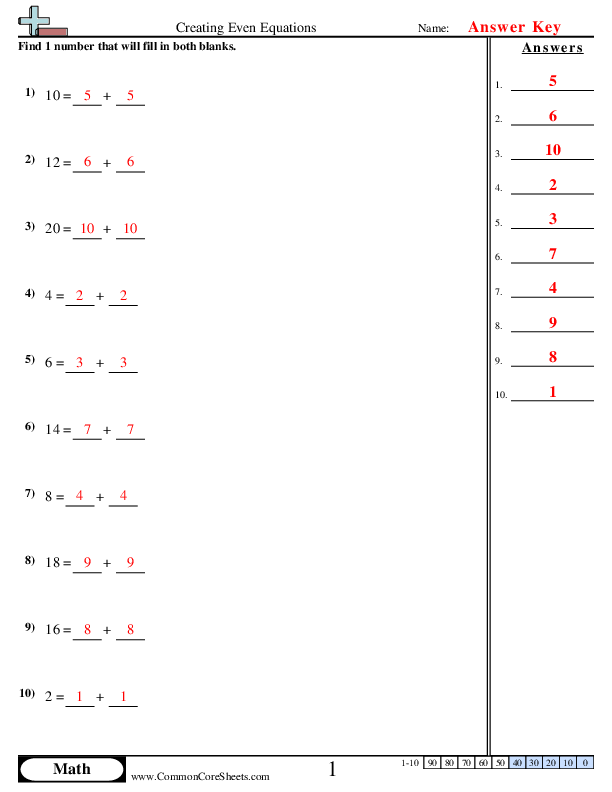
Creating Even Equations
2oa3


×
Description:
"This worksheet is designed to enhance children's understanding of even numbers and basic addition. The 'Creating Even Equations' math worksheet features 10 problems, introducing the concept through simple equalities. The ease of customization allows it to be transformed into flashcards or assimilated into a distance learning program, promoting flexible and adaptive educational strategies."

×
Student Goals:
Understanding of Basic Mathematics PrinciplesUpon completion of this worksheet, students should have gained a deeper understanding of basic mathematics principles. This includes an improved comprehension of equality and balance within equations, as well as a furthered grasp on numerical relationships. Understanding these core concepts forms the foundation for more complex mathematical learning in the future.Development of Logical ThinkingSolving these equations tasks students with using logical thinking and reasoning skills. Through this, they should enhance their ability to evaluate and solve problems systematically, applying logical thought processes to reach the correct solutions. This development of critical thinking is useful not only within a mathematical context but can also be applied to problem solving in numerous other situations and subjects.Manipulation of NumbersAfter working through this worksheet, students should demonstrate progress in their ability to manipulate numbers effectively. They will have practiced breaking down numbers into equal parts, which can help them in understanding fractions, division, and even decimal numbers later in their mathematical education.Understanding the Concept of EqualityThe concept of equality is a fundamental aspect of mathematics, which this worksheet reinforces. After completing the exercises, students would have practiced maintaining balance in equations and will be more confident in equalizing mathematical equations in the future.Enhancement of Numerical MemorizationAs students complete this worksheet, they are also engaging in numerical memorization. By repeatedly solving equations with similar number structures, they are reinforcing their memory of number patterns and sequences. This ability to quickly recall number facts is an essential skill that will greatly benefit students in speed and accuracy of solving mathematical problems.Appreciation for MathematicsEngaging with worksheets like this one can help foster an appreciation for mathematics in students. By working out problems and finding solutions, they can gain a sense of achievement and satisfaction. This can help create a positive attitude to mathematics, facilitating their progress and enthusiasm in this subject area.


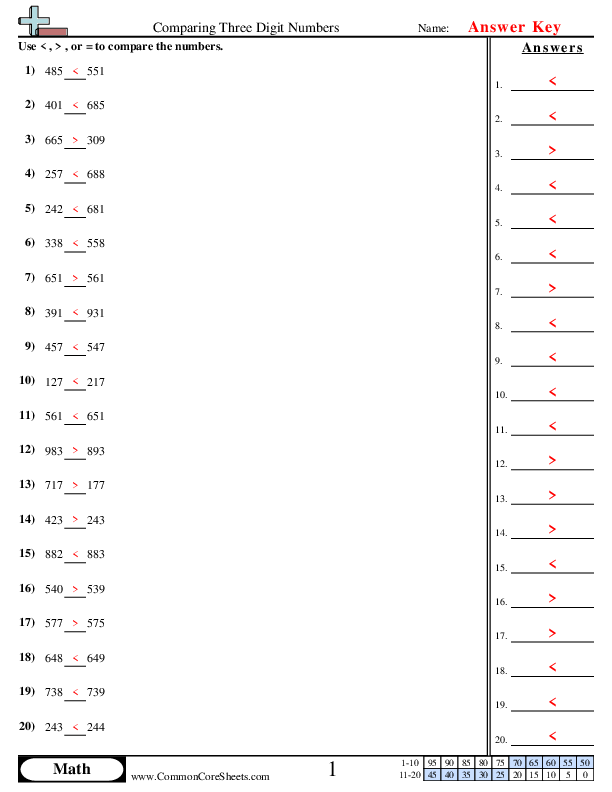
Comparing Three Digit Numbers
2nbt4


×
Description:
"This worksheet is designed to enhance children's understanding of comparing three digit numbers in math. Consisting of 20 questions, it offers practice in identifying which number is greater. With options for customization, it can be easily converted into flash cards or incorporated into a distance learning curriculum. A perfect tool for improving numerical comprehension."

×
Student Goals:
Develop Number Comparison SkillsAfter completing this worksheet, students should have a solid understanding of how to compare three-digit numbers. They should be able to look at two or three-digit numbers and accurately determine which is greater or less. This is one of the basic skills in number sense and understanding the value of numbers.Enhance Mathematical ReasoningSolving these problems should aid students in enhancing their mathematical, deductive reasoning abilities. They should be able to reason out why one number is larger, equal or smaller than the other. From understanding the value of each digit in a place to how their order influences the overall number value, students are exposed to essential mathematical reasoning principles.Improve Problem Solving SpeedThough number comparison might seem simple, individual problem-solving speed matters just as much. By successfully completing this worksheet, students should see a significant improvement in their speed when tasked with comparing three-digit numbers in the future. This speed and accuracy become increasingly crucial as they advance in their math studies.Promote Mastery of Place Value ConceptThe process of comparing three-digit numbers is intimately tied with a solid understanding of place value. After working on this worksheet, students should have enhanced their understanding of how the position of a digit within a number affects its value, and ultimately, the value of the whole number.Encourage Development of Analytical SkillsThe worksheet's complexity level encourages students to develop and employ analytical skills, leading them beyond basic memorization and towards conceptual understanding. Completing this task will aid them in successfully breaking down and interpreting numerical data, an essential component of higher mathematics and everyday numerical problem solving.Build a Solid Foundation for Advanced MathIn completing this worksheet, students not only learn to compare numbers, but also build a fundamental foundation for more complex mathematical concepts, like addition and subtraction of large numbers, and even algebra and beyond. By mastering these comparation skills, they pave the way for smoother computational and mathematical experiences in the future.


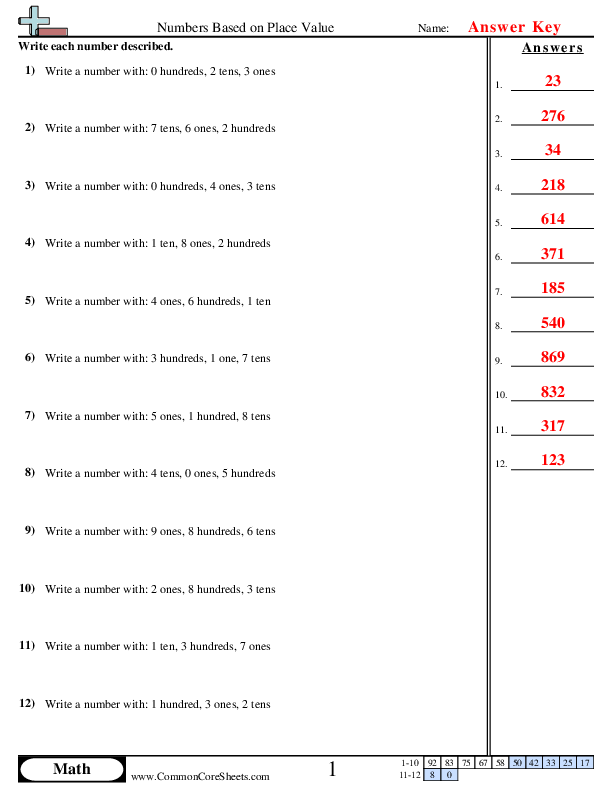
Understanding Places (3 Digit)
2nbt1a


×
Description:
"This worksheet is designed to enhance children's understanding of the mathematical principles of place value. It includes 12 creative problems where students construct numbers based on given hundreds, tens, and ones. It's versatile, enabling customization for specific learning needs, conversion to flash cards, and adaptability for distance learning. An indispensable resource for effectively teaching and learning math concepts in a varied and engaging manner."

×
Student Goals:
Understanding of Place ValuesUpon completion of this worksheet, students should have a robust understanding of place values in mathematics. They will comprehensively comprehend the concepts of ones, tens, and hundreds and how these individual units contribute towards forming a complete number.Handwriting and Formation of NumbersWorking on this worksheet will also enable students to improve their handwriting skills. Since the tasks involve writing numbers based on given number units, children will get ample practice in forming each digit from 0 to 9. This repeated practice will ensure they master the art of writing numbers clearly and legibly.Problem-solving AbilityThis activity will enhance children's problem-solving ability. It will teach them to approach written problems systematically and find solutions by utilising their understanding of place values. This not only fosters a key skill in mathematics but also cultivates an analytical mindset, beneficial across diverse subjects.Cognitive SkillsThe successful completion of this worksheet contributes directly to the development of multiple cognitive skills. Children need to read, comprehend the problem, and translate the words into numerical form – an activity that requires cognitive flexibility, working memory, and sustained attention.Fundamental Math SkillLearning place values is a building block for complex mathematical operations. By performing these problems, children will lay a strong foundation for future topics in mathematics, such as arithmetic operations (addition, subtraction, multiplication, and division), fractions, decimals, and even percentages.Confidence BoostThe successful completion of problems in this worksheet will boost children's confidence in their mathematical abilities. As they conquer each problem and see their correct solutions, they'll gain a sense of accomplishment and confidence that will contribute towards fostering a positive attitude to mathematics.Independent WorkingCompleting this worksheet also promotes working independently. Students are pushed to understand, interpret, and solve problems without any direct interference. This develops a sense of responsibility, independence, and self-confidence in their academic skills, which is crucial for their long-term academic success.









